Kansas City International Airport (MCI)
Kansas City International Airport (MCI) located 15 miles northwest of downtown Kansas City, Missouri, predominantly hosts commercial air carrier operations. The traffic mix also includes cargo, air taxi, military, and both local and transient general aviation. View a printable Pilot Handbook of the MCI information found on this Web page.
Know Before You Go
There are two parallel RWYs with staggered thresholds designated RWY 1L/19R and RWY 1R/19L. These parallel RWYs are separated by almost 6,600’. 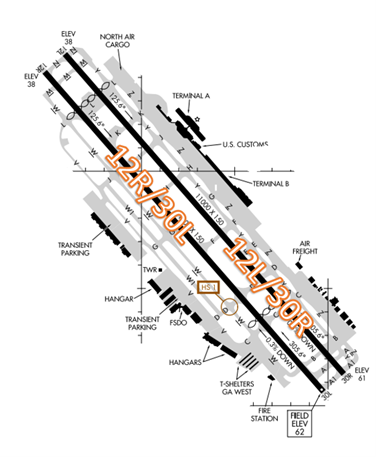
A third RWY, designated RWY 9/27, intersects RWY 1R/19L.
A complex TWY system connects all RWYs with all commercial facilities, including the only Fixed Base Operation located at the northwest corner of the field.
The airspace at MCI is Class B. (See Sectional Chart.)
MCI TWR Hours of Operation: – Continuous – 24/7.
Administrative Office Open 0700L to 1530L - M through F
Business Phone 816-329-2700.
Below find various MCI-specific information and things to be aware of, as well as general information to inform your preflight planning. This will be reviewed quarterly and updated as needed. This information is to supplement the From the Flight Deck Videos that are produced by the FAA Runway Safety Group. Here you will also find information provided by the local air traffic controllers at the airport where you intend to fly. The information is subject to change. Not for navigation or legal* pre-flight action. Always refer to official pre-flight materials such as, but not limited to, NOTAMs, airport diagrams, VFR charts and airport construction notices for the latest airport-specific details.
Hot Spots
HS 1 TWY E and TWY F intersection with RWY 9/27. Immediately after crossing TWY C, both TWY E and TWY F cross RWY 9/27.
HS 2 TWY C and TWY D intersection with RWY 1R/19L. Immediately after crossing TWY E, both TWY C and TWY D cross RWY 1R/19L.
HS 3 Expect congestion TWY B near main terminal & TWYs A7, A8, A9, A10, G and taxi-lanes S, M, N. Do not enter terminal apron without approval.
HS 4 Misalignment risk. Do not confuse TWY A for RWY 1L/19R.
Wrong Surface Intersection Takeoff
- At MCI, or at any facility where intersection take offs are authorized, there is the risk that pilots will turn in the wrong direction when turning onto the RWY.
- It is critical to verify the correct direction prior to lining up on the RWY.
- Always check your Magnetic Compass and, (if installed), your Horizontal Situation Indicator (HSI) to verify that you are pointed in the correct direction.
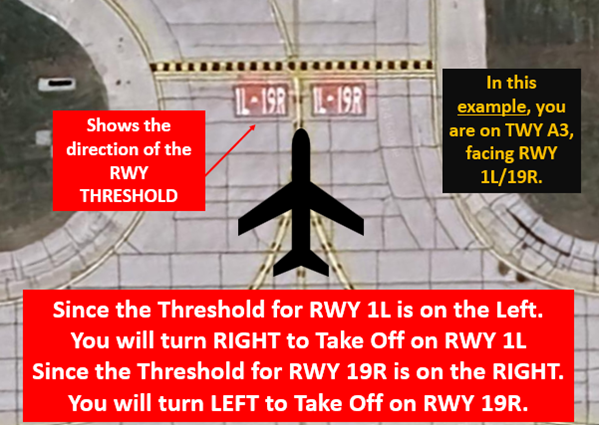
- The illustration above is just an example – apply this to your specific situation.
NOTE: FOR COMPLETE ILLUSTRATIONS AND DESCRIPTIONS OF AIRPORT MARKINGS AND SIGNS REFER TO THE AERONAUTICAL INFORMATION MANUAL – CHAPTER 2.
Wrong Surface TWY Takeoffs and Landings.
- There are parallel, full-length TWYs adjacent to the RWYs at MCI.
- The risk of taking off or landing on a TWY exists.
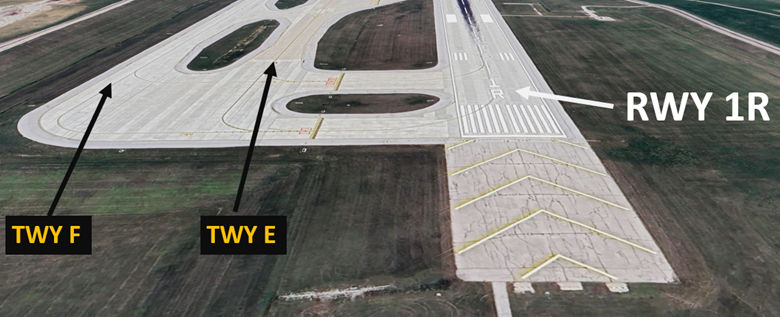
RWY markings are WHITE. Markings for surfaces that are not used for takeoff or landing are YELLOW. - The illustration above is just an example – apply this to your specific situation.
Additional Information
- Airport Surface Surveillance Capability (ASSC) in use. Operate transponders with altitude reporting mode and ADS–B (if equipped) enabled on all airport surfaces.
- Windshear alert system on airport.
General
- Parallel RWYs with a crossing RWY. Each RWY has two separate parallel TWYs with multiple intersections. All ramps are uncontrolled except for the new single Terminal Ramp.
- MCI is within Class Bravo airspace, pay close attention to affected altitudes when entering.
Traffic Patterns
- VFR pattern altitude is as assigned based upon other traffic in and around the airfield.
Ground Control
- If parking at Signature ramp, there are radio blind spots within the ramp area. Begin moving away from the building to improve radio coverage. Use caution when exiting the ramp, pay close attention to the service road that parallels TWY Bravo. Pilots have mistaken the service road for Bravo TWY and joined the service road when beginning taxi.
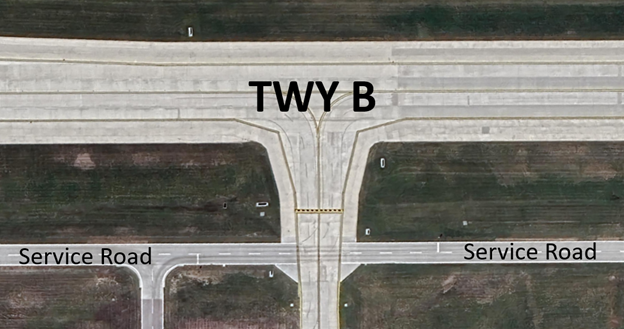
RWY Crossings
- Minimal crossings are required at MCI. Expect to cross RWY 9/27 when assigned RWY 1R and to cross RWY 1R/19L when assigned RWY 27.
Takeoff/Departure
- Departures can typically expect RWY 1L/19R, when available.
- Aircraft under flow programs or timed delays may be assigned 1L/19R or RWY 9/27.
- MCI TWR utilizes TWR assigned headings dependent upon aircraft type and performance.
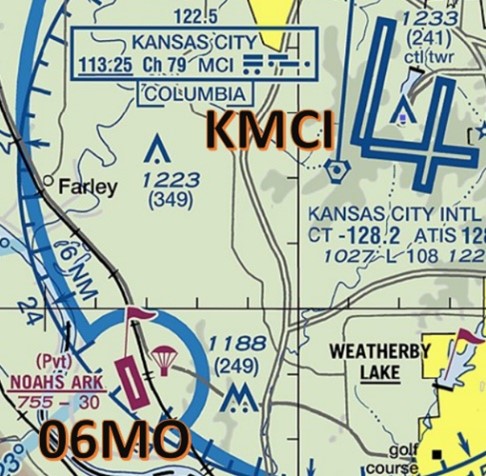
- Noah’s Ark Airport (06MO) conducts parachute jumping approximately six miles southwest of KMCI from the surface up to 14,500’ MSL.
- When parachute jumping operations are in effect TWR assigned headings are restricted to protect that airspace.
Arrival/Landing
- On initial contact advise if you are parking at Customs, Signature, Joint Use Cargo, or Jet Midwest ramps.
- When parallel RWYs are in use, if you are inbound from the east plan RWY 1R/19L, if inbound from the west plan for RWY 1L/19R.
- When using high-speed exits C4 and C6 continue until first parallel TWY, then use extreme care when turning in excess of 90 degrees.
Weather
- Kansas City is impacted by “Thunderstorm Season” typically between the months of April thru June.
- Our “Winter Weather Season” encompasses November thru February.
- To assist with rapidly changing weather conditions, MCI has a 24-hour ATIS which is available on frequency 128.375.
Avoidance Areas
- Noah’s Ark Airport (06MO) when parachute operations are in use. (See above.)
- Special Traffic (Military / Commercial / Helicopter, etc.)
- From time-to-time C-130’s from the Missouri Air National Guard Unit, stationed at Rosecrans Memorial Airport (STJ), will come down to MCI and join the VFR pattern.
Additional Information
- The Kansas City Overhaul Base manufacturing and maintenance plant located on the eastern side of the airfield, just north of RWY 9/27, has multiple decommissioned aircraft parked.
- Eastern Airlines also has a maintenance shed located on the ramp.
